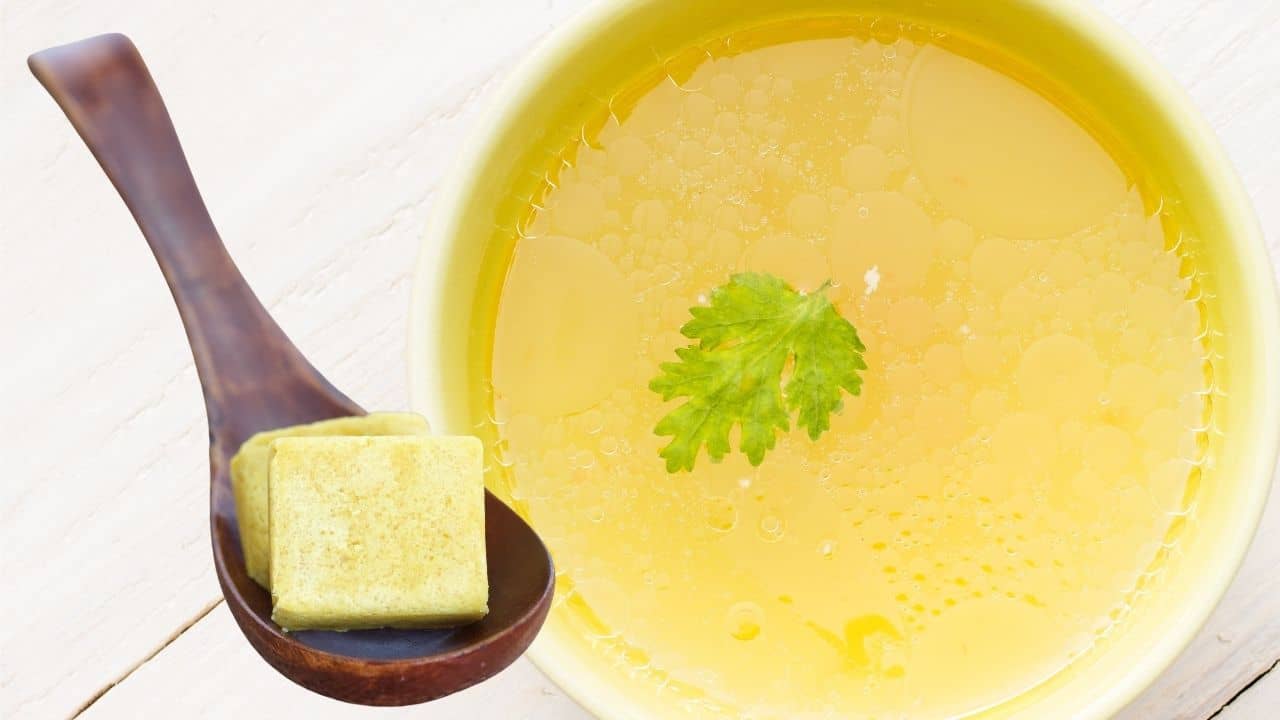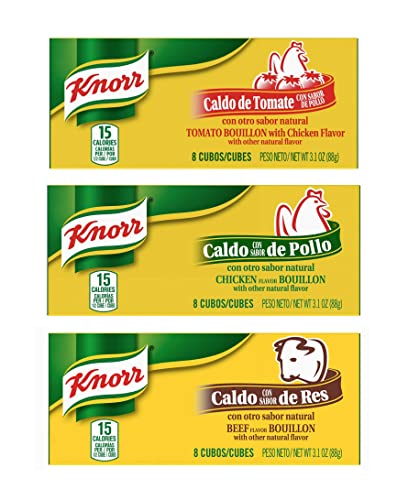Chicken broth is used to make soups, sauces, and stews, and you can even make a bowl of delicious rice. Making chicken broth from bouillon cubes is a lot easier than creating it from scratch. It is undoubtedly faster than making your own classic stock with roasted bones and vegetables. (I will cover the main differences between stock and broth below).
Making Chicken Broth With Bouillon Cubes
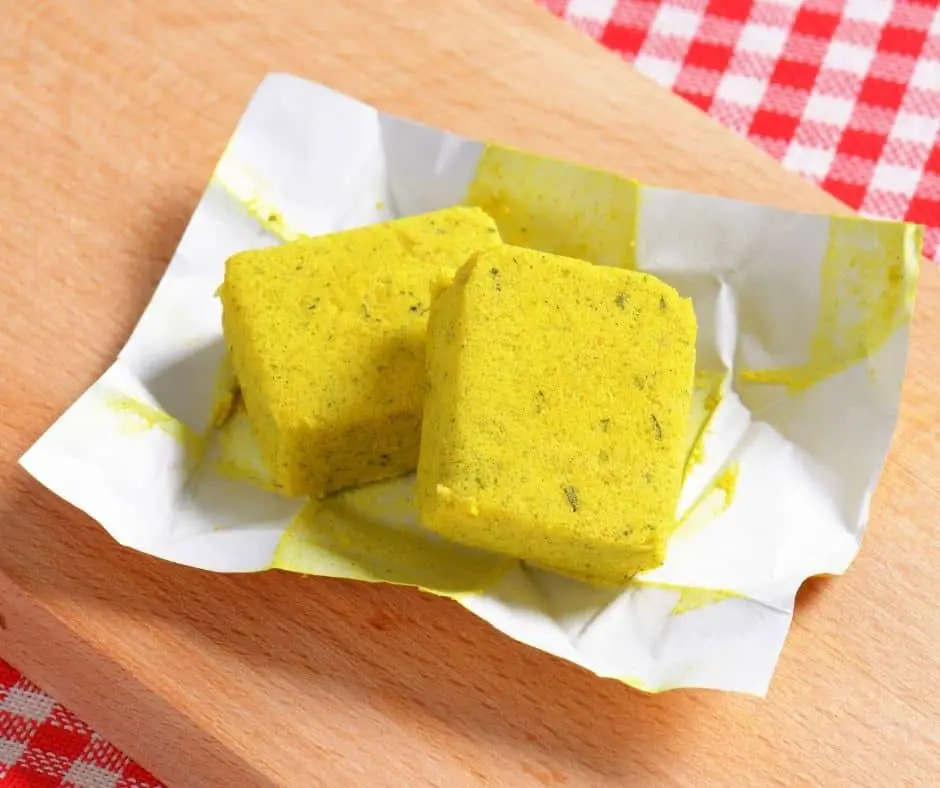
Using bouillon cubes to make chicken broth is an easy process. To make one cup of broth, place a whole rectangular cube (or crumble it) in 2 cups (500 mL) of boiling water and mix until the bouillon has dissolved. Then use the broth in the recipe as required. If you need more broth, then just increase the ratios accordingly.
Although the ratios for using different bullion cubes are quite universal, always check the instructions on the package. Each manufacturer will tell you their recommended proportion of bouillon cubes to the water.
Alternatively, you can always add the cube directly to the dish as you are cooking. If you are making a stew and are not sure how many cups of water are in there, you can use one bouillon cube per serving. For example, if the dish you are making serves 2 people, then use two cubes.
When adding bouillon cube straight to the dish, you have to take into account the other seasoning you have already used as bullion cubes are quite salty.
So, always start with one cube and then add more as needed. As you can see, making chicken broth using bullion cubes is quite simple.
But can you use bouillon/stock cubes when a recipe calls for broth and not stock? Or is it stock? How do broth and stock differ? Are they interchangeable?
Read on to learn more about the differences between broth and stock.
Chicken Broth vs. Stock
What Is Chicken Stock?
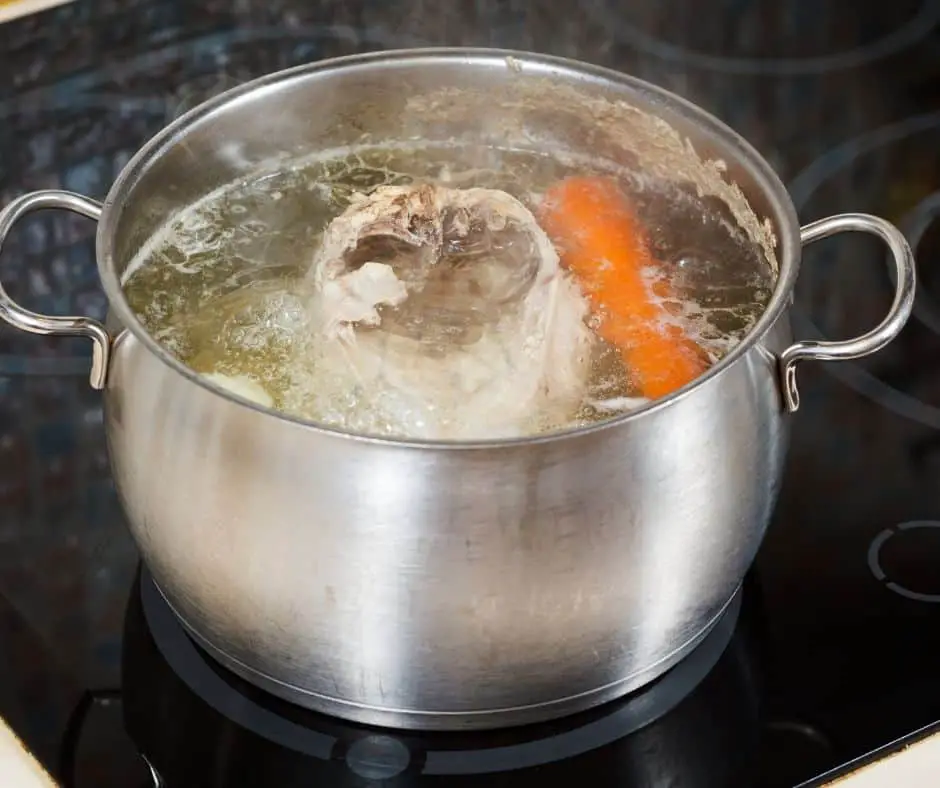
The term stock refers to a liquid made from simmering a whole chicken, any of its parts, or a mixture of both. Chicken stock is usually made using chicken scraps and hacked-apart bones that have already been cut and carved up for other uses. Often vegetables like onions, carrots, garlic, parsley, or celery are added to the mix.
Stock always requires some bones to make, although not necessarily meat. Some recipes call for a splash of acid, such as lemon juice or apple cider vinegar, which is added to help the process along.
When making stock from uncooked chicken, bones are usually roasted first, making for a richer, more flavorful stock. However, this step is not essential to the process.
To get a wholesome, clear stock, these bony parts of the chicken are simmered at low temperatures for hours to allow the nutrient-dense marrow and collagen in them to leech out to create a savory stoke.
Making chicken stock from scratch can take anywhere 2-15 hours to cook. If you don’t simmer it long enough, you risk not extracting all the enticing flavor, nutrients, and gelatin from the bones.
Also, homemade chicken stock is not usually salted to avoid over-seasoning your final dish.
How Is Chicken Broth Made?
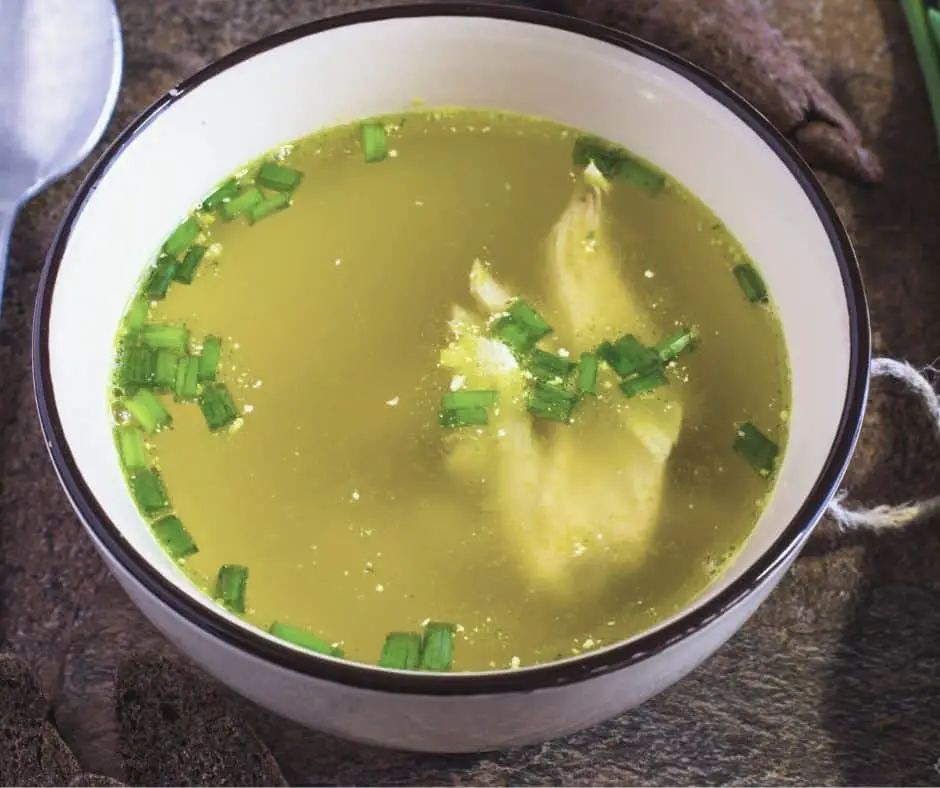
Making chicken broth follows a similar process, but it usually includes just meat and vegetables in the mix as well to offer a variety of flavors.
The critical difference is that a stock will be rich in nutrients, minerals, and collagen from the bone marrow, whereas a broth will not. Because there are no nutrients and collagen to extract, making chicken broth takes far less time, usually no more than an hour.
Now, when it comes to your general cooking needs, the two are interchangeable, unless you are making a velouté sauce for Gordon Ramsay. They can be used as an exact replacement for one another.
If you have a recipe that calls for stock, but you only have broth on hand, take comfort in knowing you can use that broth to make a meal that will be just as tasty as if you had used stock.
So, based on these definitions, does this mean that a bouillon cube results in broth or stock?
Do Bouillon Cubes Give You Broth Or Stock?
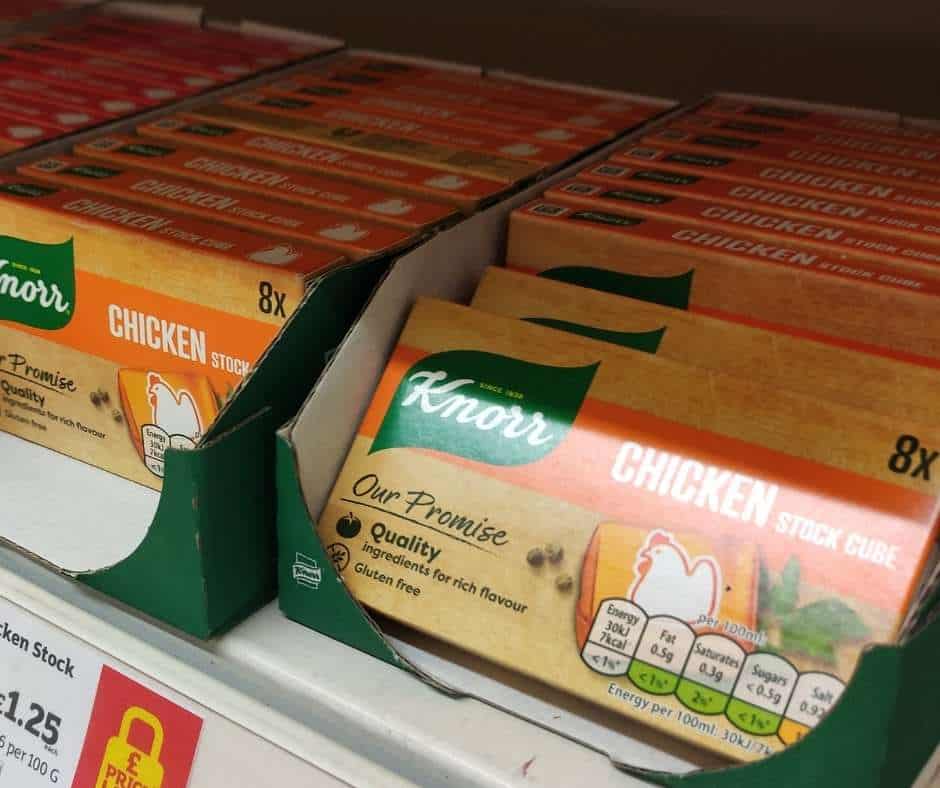
I would say that no bouillon cubes can match up to the homemade stock, full of collagen from joints and bones obtained from long-term cooking.
For one, there are very few minerals and nutrients in bouillon cubs. They are, in general, very high in salt and contain other additives and possibly artificial flavors, thickening, flavor enhancers, monosodium glutamate, or starches.
In addition to the ingredients above, you may also find corn starch and other corn byproducts, as well as chicken and beef fat in them. They also contain various dried seasonings such as parsley, granulated onion, and garlic powder.
Some brands will even include sugar and anti-caking agents such as silicon dioxide.
So, according to the definitions of broth and stock, any commercially available cube will result in – by definition – a broth.
Advantages Of Using Bouillon Cubes
Now, that said, there are still some great things about bouillon cubes:
- They are flavourful
- Very easy to use
- Labor-saving
- Fast to make and convenient
- Suitable for most recipes that call for broth or stock
- Give your dish a nice color
- Long self
- Low in calories
- and low-cost
Which Bouillon Cube Are The Best?
Are all bouillon cubes created equally?
In general, more or less, but some brands are more popular than others and are far easier to find on most supermarket shelves.
Knorr
This popular brand is owned by British company Unilever, but it is available all over the world. In addition to their popular cubes, they also make other condiments. Though chicken is the most popular flavor, their product offering includes other flavors such as beef, shrimp, ham, tomato chicken, and low-sodium chicken.
Knorr’s variety of flavors is far more robust than that of other brands. They even offer vegan-friendly vegetable cubes seasoned with granulated onion and garlic.
Their cubes are some of the best on the market. They are soft and pliable, so they can easily be added directly to a dish to dissolve as you cook. And, of course, they dissolve easily in boiling water to make a quick broth.
Savory with a hint of herb flavor, it is clear to see why this brand is so popular.
Their only downside is in some of their ingredients. They contain some ingredients like Yellow 5 and Yellow 6, which are artificial food colors. They also contain a small amount of palm oil (saturated fat) or partially hydrogenated soybean oil. That may not sound awful, but that is a fancy way to describe trans-fat. Though it is just a small amount, trans-fats are best to be avoided.
BOU
Although Knorr, Maggi, and OXO are some of the market leaders and certainly tried and tested choices for making good-tasting broth, I think you could still try some newer and perhaps an even better option.
One of them is a company called BOU. They describe themselves as grab-and-go pros and self-proclaimed flavorphiles.
Indeed, they are not as popular as some other brands. Still, their bouillon cubes offer an excellent selection of ingredients that certainly differ from what the big boys have to offer.
BOU chicken bouillon cubes are packed with ginger, garlic, lemongrass, coconut concentrate, leek powder, the root of turmeric, and other natural flavorings. In addition, BOU cubes contain over 20% less salt than many other leading brands, and they are gluten-free.
Packaged as prewrapped cubes and sealed in a jar, they are easy to unwrap and use. They are simple to use and dissolve easily in any number of dishes.BOU cubes are perfect for marinades, sautés, soups, and sautés, or you can just make delicious broth on its own.
One BOU cubes give you 2 cups of chicken broth.
Herb-Ox
Though Herb-Ox is also a lesser-known brand, most people have heard of the company Hormel which owns it. They offer beef, chicken, and also vegetarian cubes.
Though the above-mentioned brands will yield two cups of broth per cube, the Herb-Ox cube only results in one cup of broth. Unlike the others, they have an excellent sodium-free range, using Potassium Chloride with a salt-like taste as their main ingredient. This is great for anyone in your home who may be avoiding dairy.
I also like this product because they use turmeric extractives instead of artificial coloring, which gives the broth a really lovely yellow color.
The blend of ingredients results in a flavor that is popular in many soups and stews. All flavors dissolve easily and do a great job of adding flavor to any dish.
Super Easy Chicken Bouillon Cube Recipes
Have you officially been inspired to use a bouillon cube in your next dish? Ok, probably not inspired, but if you are in a hurry and want to whip up a flavorful, savory dish, check out a few of my easy yet delicious recipes below.
These are not going to win any culinary awards, but both are super simple and flavorful.
Quick And Easy Chicken Soup
Ingredients: (serves 2)
- 2 chicken bouillon cubes
- 4 cups of water
- 1 carrot (sliced)
- 2 ounces (56g) of tagliatelle or linguine (or any noodles or pasta)
- parsley for garnish
Instructions:
- Dissolve 2 stock cubes in 4 cups of boiling water.
- Add one sliced carrot.
- Add pasta.
- Simmer for 10 minutes.
- Garnish with parsley.
- Now the soup is ready to serve.
Chicken Flavored Rice Made With Chicken Broth
Cooking rice with chicken bouillon cubes is one of the easiest ways to make a flavorful bowl of rice that makes a great side dish or can be eaten as a meal on its own.
Check out the video below on how to make this super easy delicious rice infused with chicken broth.
Read Also: 13 Flavoursome And Nutritious Detox Soups For Weight Loss
Homemade or Store Bought?
Should you use bullion cubes, or does it make more sense to make your own broth from scratch? The answer may vary for everyone. The two most likely things that keep any home cook from making broth or stock from scratch are ingredients and time.
Whether you are making broth or stock, a slow and long simmer is a must. Especially when making chicken stock, this may require leaving the ingredients to cook overnight. If you just do not have the time, willingness, and ingredients, then working with bouillon cubes is certainly the next best thing that will result in a cup of warm and flavorful broth in minutes.
Read Also: 6 Ways To Heat Up Canned Soup (Without Using The Can)
